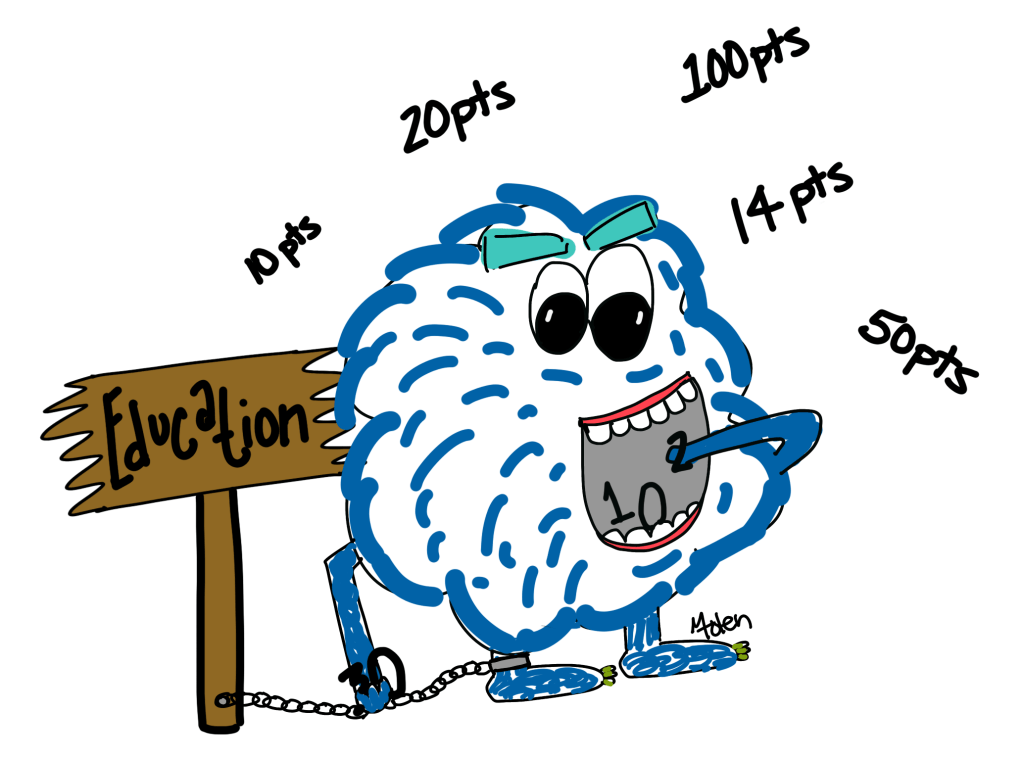If you follow my Infinitely Teaching blog, you saw my post last week about my desire to stop feeding the point-gobbling monsters in my classroom and encourage thinking and learning.

Well… I bought Building Thinking Classrooms in Mathematics by Peter Liljedahl when it was released earlier this year. It sat by my chair as the year ended because I couldn’t find the desire to read or do much school related. It sat by my chair through early summer because I couldn’t find the desire to do much school related. I’m glad to say my desire to think about school has returned and I read it in a day, with many many flags sticking out of the book.
I LOVE IT, and I’m so excited to extend what I already do in my classroom.
See, I have been doing MANY of the principles he talks about in his research based book, I just need to make a few changes.
- My students already work at the board (vnps), but I will implement his methods of scaffolding and questioning at the board and not at seats.
- I make random groups. I have restructured my random grouping cards to make groups of 3 and not 4. You can find those HERE.
- I have been using standards-based assessments so only minor tweaks are needed here.
- My classroom is already defronted (well except for last year when they wouldn’t let me because of COVID) but it is slightly symmetric (because that’s how I roll) so I’m working on a plan to make it randomly defronted.
- My “practices” were already not for points and I also provided the answers. I will be changing this to the Check Your Understanding language and have students self assess over them
I’m really excited about the consolidation and notes idea. Really, I’m excited about most of it. And I can’t tell you how excited I am about being excited because last year really sucked the life out of me.
So I have updated my standards and started making my scaffolded board curriculum tasks. I have also started making the note pages (as recommended in the book) since I will be using this with 9th and 10th grade students. I have updated my syllabus (we are required to give one) to represent these new changes and I feel like I’m finally ready to greet a new group of students.
I will be weaving the pillars and practices from Nolan Fossum into this process but I think it will be so much easier since the pillars are basically built-in to the Thinking Classroom framework.
I’ve already convinced two people to buy the book (I get nothing from this, I just think it’s wonderful!) and I hope, if you want to create thinkers and not doers, that you buy it too.
There is also a thinking classrooms website if you want to see a basic overview of what he talks about in the book.
Yay Thinking Classrooms!!!


Hi Mandi! 🙂 I also took a break, but when I read the book, I was so inspired! I’m very much so looking forward to learning and growing in making my classroom a thinking classroom. 🙂 THANK YOU for your support and blog, as well as sharing your sorting cards. It’s super helpful for the start of the school year. 🙂 Have a lovely start of the year! -teacher from California
LikeLike
Hey Mandi!
I also reluctantly waited and waited and waited, but I finally picked it up and couldn’t put it down! I’be got two chapters left but I’m planning on finishing then tonight…I am not quite so prepared as you but excited to see how this thing goes. I’ve got non-curricular tasks for this week and then I’ll start curriculum tasks for Geometry and Precalculus next week! I’ll be definitely keeping up to date on your stuff though! Good luck!
LikeLike
Hi Mandi,
I found your post as I was Googling “How to lesson plan in a thinking classroom”. I was wondering if you had any tips. I read the book and absolutely loved it! I’m 100% on board to try, I just want to make sure I’m prepared. I have lots of non-curricular activities planned, but I want to make sure that my curricular activities are good. Any tips?
Thank you
LikeLike
When I’m planning my lessons, I try to find an entry point for the class to be successful. Sometimes that means a little review during the intro. I really do stick to the change one small thing each time to build up. I try to only work on one concept each day but if we need 2, we have a consolidation first then introduce the new part. You will go slower than most classes but the students learn at deeper level.
LikeLike